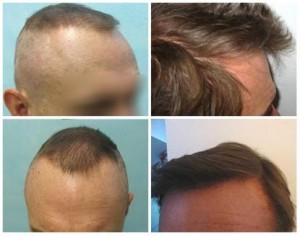Surgical techniques for hair transplantation can be grouped as older techniques versus more modern techniques, such as F.U.E.
Evolution of Surgical Hair Replacement Techniques
Older Surgical Hair Replacement Methods
A credible presentation of the evolution of surgical hair replacement techniques must begin by a review of older methods much of which are no longer in vogue. Punch grafting is a hair replacement technique which emerged around 1955. It uses a specialized instrument to punch out cylindrical shaped grafts of skin, “plugs” from the donor area. This not only leaves scars that look like dots, but the transplanted hair is tufted the way hair exits on the heads of dolls.
Temporo parieto occipital flap surgery has been used since 1969 to reconstruct the anterior (front) hairline by surgically pulling areas of the scalp with ample hair forward. This results in a horizontal scar around the top part of the forehead.
Scalp reduction which became popular in the 1970s is another older hair replacement technique where the surgeon surgically removes areas of the scalp and then stitches them together in order to reduce the area of baldness. This is done prior to inserting grafts of donor hair.
Modern Surgical Hair Replacement Methods
More modern hair replacement methods include
- F.U.T. (Follicular Unit Transplant), also known as strip surgery or F.U.S.S. (Follicular Unit Strip Surgery)
- F.U.E. ( Follicular Unit Extraction )
In strip surgery, the physician removes a horizontal strip of skin from the posterior part of the scalp. This strip is then dissected into individual grafts that are transplanted into the bald areas. Not only does this process leave a linear scar, hair from the back of the head is quite thick. Cosmetically this often looks very unnatural when used for hair replacement to reconstruct anterior hairlines.
Strip surgery has been around since the early 2000s. However, in more recent years, Follicular Unit Extraction has evolved as the more preferred and effective choice for surgical hair replacement.
In Follicular Unit Extraction, the doctor removes follicular grafts consisting of 1-5 naturally grouped clusters of hair follicles and reinserts them into the target area. This approach is capable of producing the most natural looking results, especially since the technique has evolved to include body hair (e.g. from the beard and other regions) when donor supply is limited.


